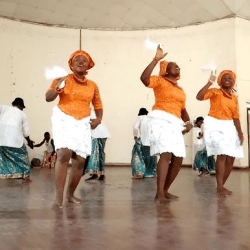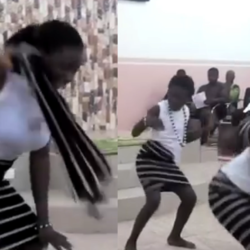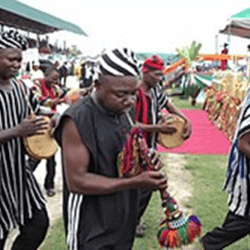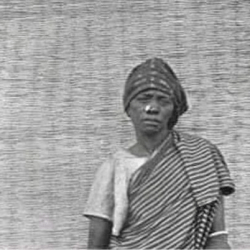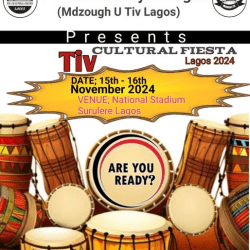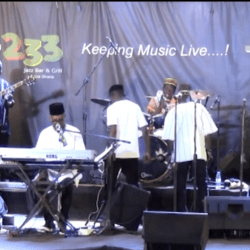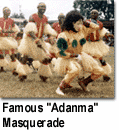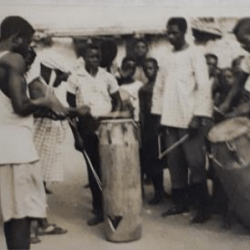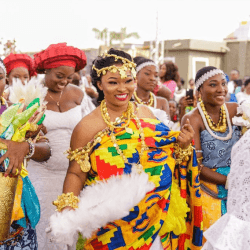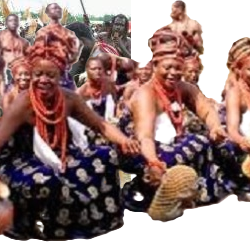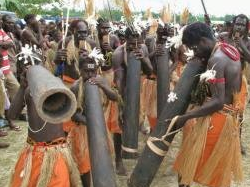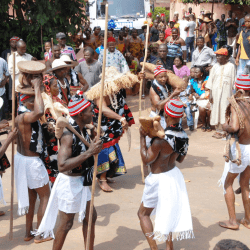Eke-gene is a rich Ijaw cultural dance, which originates from the Epie speaking area of Bayelsa State. Eke-gene, which literally means, “big dance”, has a medley of about six local songs with various dance patterns. This is one of the most spectacular dances in the repertory because of the colorful costumes and the beautiful dance.
Music & dance in Bayelsa

FISHERMAN’S DANCE
This dance is a contemporary piece, which teaches the occupational predisposition of the Izon people. It is suitable for presentation at ceremonial occasions. It has variety of movements depicting the different stages in a fishing expedition: paddling (the journey for the fishing site), casting of nets, taking the catch into the canoe for their wives to put in their fishing baskets, washing periwinkles, and rejoicing over a fruitful fishing expedition.
BENI-ERE
This is a dramatised “Ngu-sei,” an age long traditional dance in Ijaw villages. Ngu means pot, while Sei means dance, so in totality it means pot dance. Oral history has it that a woman who came from the river brought this dance. She introduced this kind of dance and taught the people of the community. She decided to settle in the community finally. However, because of great beauty, many suitors asked her hand in marriage: the rich, the wealthy, the poor, farmers and fishermen. As it were, she turned all of them down and finally fell in love with a disabled man who eventually married her. Dances like Ngu-sei are demonstrations of the Izon rich cultural heritage, which we can project in international cultural festivals. This dance is always enjoyed by all and sundry because the message is apt: there is ability in disability.
ELASEI
This is an installation dance by seven maidens. Various movements and patterns portray the installation story. The performance of this dance is mostly at social gatherings and it highlights the rich cultural heritage of the Izon people.
WIND AND TREES
Wind and Trees is a festival dance showing the forest and the forest people playing together thus depicting how wonderful God’s creatures are. It is mainly danced by male and female dancers showing the footsteps of the wind and trees; and people who move in the forest. Every movement of the dance is has strong as the wind and trees.
HEART BEAT
The dance, Heart Beat, originates from the Yoruba speaking area of Nigeria. History tells us that with the coming of the Europeans to Africa, they taught the natives the European ways of life. Eventually, some of the missionaries decided to send some boys and girls (who were seen to be very brilliant) abroad to undergo further studies. Most parents were afraid to release their children, thinking the white people could kill them. However, some parents allowed theirs to go with them. Upon their return after several years abroad, the Yorubas saw a great change in their life styles and they were happy about this development. These boys and girls came home with this dance. In its present form, some Yoruba dance steps embellish it. Therefore, Heart Beat is a combination of western and African dance steps. Its performance could be at any kind of occasion. Ebinimi Richman choreographed this dance.
Bayelsa
Bayelsa is a state in Nigeria. It is located in the southern part of the country.

Created on October 1st 1996 from the old Rivers State, it’s bounded to the east by Rivers State and west by Delta State, the beautiful waters of the Atlantic Ocean dominates its southern borders.





It has the longest coastline in the West African sub-region making the State a tourists destination.

Bayelsa State consists of 8 Local Government Areas:
- Brass
- Ekeremor
- Kolokuma/Opokuma
- Nembe
- Ogbia
- Sagbama
- Southern Ijaw
- Yenagoa


The name Bayelsa is derived from a combination of acronyms of three Local Government Areas within its confines: Brass LGA (BALGA), Yenagoa LGA (YELGA), and Sagbama LGA (SALGA). The state is made up of 8 Local Government Areas; they are Ekeremor, Kolokuma Opokuma, Yenagoa, Nembe, Ogbia, Sagbama, Brass and Southern Ijaw.
The beautiful city of Yenagoa serves as the Capital City which plays host to most of the Government and private institutions.


The four main languages spoken are Izon, Nembe, Ogbia and Epie-Atissa. Like the rest of Nigeria, English is the official language.

Bayelsa State has one of the largest crude oil and natural gas deposits in Nigeria. Bayelsa is often described as the cradle of Ijaw culture and tradition because of its rich culture and tradition that dates back to so many centuries.
Fishing is the major occupation of Bayelsa people because of the abundant creeks, lagoons, rivers and swamps within which commercial fishing is practiced. Over 200 species of fish can be found in the waters within and around the state. Fish oil extraction is a common economic activity throughout all the LGAs of the state, and the coastal areas abound in sea foods such as fish, oysters, crabs, lobsters, periwinkle et cetera. There are also sea animals such as Hippopotamus, manatee, crocodile etc. in the seas, rivers and streams that crisscross the state.
Food crops grown in the state include yam, cocoyam, banana, pineapple and plantain. Cash crops grown in the state include coconut, pears, oil palm and raffia palm. The potentialities for the development of these crops to feed local industries are very good. Technologies are being developed to reclaim land from mangrove swamps in order to cultivate food, especially lowland rice and the cash crops identified above on a large, commercial scale.
Location: Bayelsa is geographically located approximately within Latitude 4°15 North at the Southern part & 5°23 North at the Northern limit and Longitude 5°22 East at the Western part & 6°45 East at the actual Eastern limit. It is bordered by Delta State to the West, Rivers State to the East, the Atlantic Ocean to the South and both Rivers and Delta States to the North.
Geology: Domiciled within the lower delta plain believed to have been formed during the Holocene of the quaternary period by the accumulation of sedimentary deposits. The major geological characteristic of the state is sedimentary alluvium.
Soils: The major soil types in the state are young and shallow,(inceptisol Aquepts) and acid sulphate soils (Sulphaquepts). There are variations in the soils, some soil types occupy extensive areas whereas others are of limited extent. However, based on physio graphic differences, several soil units could be identified in the state.
Climate and Vegetation: Rainfall in the State varies in quantity from one area to another. The state experiences equatorial type of climate in the southern the most part and tropical rain towards the northern parts. The average monthly temperature is in the range of 25°C to 31°C. The hottest months are December to April.
Minerals: With the largest crude oil reserve in the Niger Delta of Nigeria, the state produces over 40% of the country’s on-shore crude oil and vast quantities of associated gas. It also has large deposits of clay.
